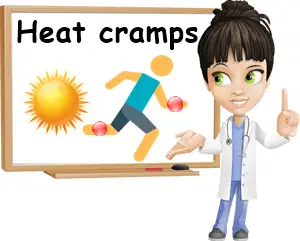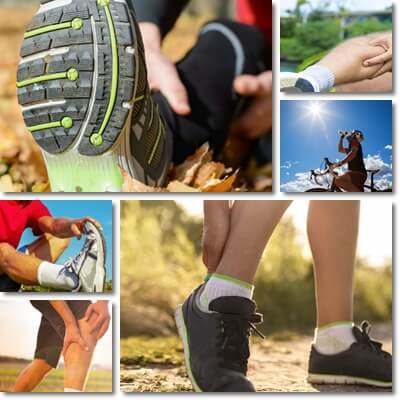Heat cramps are one of the first symptoms of heat stress, the thermal physiological stress caused by prolonged exposure to high temperatures. They are a first stage of heat-related illness and may precede heat exhaustion and heatstroke. They are known to occur spontaneously, often a result of intense physical activity performed in high temperature conditions. Heat cramps are associated with profuse sweating which results in dehydration in the form of loss of fluids and electrolyte imbalances.
What are heat cramps more exactly?
By definition, heat cramps are often painful muscle spasms that occur unexpectedly following prolonged exposure to high temperatures. Normally, muscles contract and relax to facilitate movement – they relax in resting position and contract when flexed. But when they contract involuntarily or abnormally, it results in a convulsion – essentially a spasm or contraction. In the case of heat cramps, the muscular contraction can be either continual (muscle remains contracted for seconds or minutes at a time) or alternating with muscular relaxation (in a rapid, involuntary manner).

If the muscle is in continual contraction and doesn’t relax at all, then it’s also a source of debilitating pain. The longer it stays contracted, the more severe the pain. If there is a rapid alternation – muscle contracts and relaxes at abnormally rapid intervals -, then there should be little to no pain. However, painful muscular cramps are the type most often reported in relation to heat stress. Heat cramps most commonly affect the calf muscles, feet, thighs (front thigh, back of the knee region), hands, shoulders, back or abdominal area. Typically, the feet and calf muscles are the most affected as a result of physical exertion (example: running, walking).
What causes heat cramps?
Prolonged exposure to high environmental temperatures creates the perfect setting for very specific physiological responses that lead to the onset of heat cramps. More exactly, high temperatures trigger sweating as a means of cooling down – the human body functions optimally only within a certain temperature range and sweating helps the body lose heat and cool down. But there’s only so much water available for sweating and, if it’s not replaced quickly, dehydration installs and leads to the onset of heat cramps. Moreover, dehydration also causes loss of electrolytes which impairs brain-body communication and results in muscles contracting involuntarily or irregularly, hence the cramps. Not to mention you can’t replace electrolytes and restore electrolyte balance with just plain water which is what many people have access to right away.
So heat cramps causes include two types of dehydration:
1) Loss of fluids, essentially water, as a result of sweating in response to exposure to high temperatures.
2) Loss of electrolytes (also called salts): primarily sodium, potassium and magnesium. Electrolytes can be lost through sweating and depleted by physical exertion (example: exercising when it’s hot outside).

Examples of situations that can lead to the onset of muscular cramps:
1) Hot weather – more likely to lead to heat stress and related illnesses, including cramps. This is because a rise in temperature increases both water and electrolytes requirements and some people may not be able to correctly estimate their growing requirements.
2) High humidity (in combination with high temperatures) – prevents sweat evaporation from the surface of the skin and, consequently, heat loss. But dehydration still occurs.
3) Not getting enough fluids, especially if it’s hot outside, at work or you’re exercising plentifully.
4) Not getting enough electrolytes – especially if temperatures are high and you are exercising a lot.
5) Physical exertion in high temperatures – manual labor, exercising or any form of intense physical activity accentuate dehydration, especially if you’re not replenishing lost fluids and electrolytes.
6) Being outdoors when it’s hot outside – exercising or working outdoors in hot weather.
7) Lack of ventilation or air conditioning in living areas or work establishments.
8) Poor dietary and lifestyle habits – drinking coffee, green tea, caffeinated beverages, alcohol, energy drinks or simply not drinking enough water amplify dehydration and increase the likelihood of heat cramps.
What does a heat cramp feel like?
1) Painful muscular contractions. A muscle or part of a muscle contracts unexpectedly which restricts movement. It feels as if you don’t have control over the muscle and can’t relax it. The contraction may continue for a few seconds (10-15-20-30 seconds) or minutes (2-5-15-20 minutes) and generates intense pain. The longer it lasts, the greater the pain sensation.
2) Painless muscle spasms. Muscles contract and relax involuntarily, at abnormally rapid intervals. You can feel the muscle moving, but it doesn’t hurt because it goes from contracting to relaxing – the same sequence of events that normally facilitates movement. But instead of being voluntarily, the contract-relax sequence is involuntary, unintentional. In other words, the reason why these types of heat cramps don’t hurt is because the muscle is not stuck in the contracted phase.
What do heat cramps look like? The painful cramps, which are the ones that last for seconds or minutes, look like a piece of muscle is tight and somehow sunken in. The more toned the muscle, the more visible the contraction. The affected area tends to be more localized, or restricted to a small portion of a muscle. The involuntary spasms make the muscle look like it’s vibrating or breathing. Despite the fact that the movement is involuntary, it occurs at fixed, regular intervals which makes it interesting to look at.
Heat cramps signs and symptoms
The main symptom of heat cramps is the muscle contractions/spasms, usually the painful type.
However, the prolonged exposure to high temperatures causing the dehydration behind the heat cramps is also a source of other symptoms. These may precede or occur coincidentally with the cramps or persist after the cramps have resolved. Other symptoms may include: heavy sweating, red, moist skin, itchy skin rash as a result of high temperatures, thirst, dry mouth, dry throat, chapped lips as a result of the dehydration, fast heartbeat, low urine output and dark urine colors (see Urine Colors Meaning).
Treatment options and remedies for heat cramps
For immediate relief (applies to painful heat cramps):
1) Cease all forms of physical exertion immediately.
2) Rest/lie down (preferably in the shade/cool place).
3) Apply moderate pressure on the contracted muscle and begin a vigorous but gentle massage.
Continue with the massage to force the muscle to relax. It may take anywhere from 2 minutes to 15 minutes or more.
4) Once the contracture is gone, continue to rest a little longer.
5) Replenish lost fluids and electrolytes. Your best options are: naturally carbonated water (which usually has salts like sodium, potassium, magnesium, calcium), sports drinks (with salts and sugar), rehydration solutions/electrolyte replacement solutions (salts that require dissolving in water) or, if nothing else is available for the moment, plain water.
6) Wait a few hours or days before resuming physical activity, especially if it’s heavy, strenuous exercising (recovery time depends on how well and fast you can rehydrate yourself). If you are a professional athlete, know that muscles affected by heat cramps are more prone to strains and injury in general so it’s a good idea to have your doctor take a look and clear you for exercise.
7) If the affected muscle feels too hot, it may help to apply a damp towel or ice packs covered in a towel. It’s important to avoid big temperature differences that could stress the muscle further.
Long-term treatment options which double as prevention apply to both types of heat cramps and include:
1) Keep hydrated by drinking enough fluids and meeting your electrolytes requirements.
Remember physical exertion (manual labor, intense exercises) and profuse sweating increase requirements for both fluids and electrolytes – while your muscles use up electrolytes, sweating depletes both electrolytes and fluids. Adapt your intake accordingly.
2) For replenishing both fluids and electrolytes, your best options are sports drinks (with salts, vitamins and sugars), naturally carbonated water (with naturally-occurring salts), rehydration solutions or electrolyte replacement solutions (which need to be dissolved in plain water).
3) For replenishing just fluids, your best options are all of the above and plain water (still water), fruit juices, vegetable juices, herbal teas without caffeine.
Absolutely avoid coffee, green tea, white tea, black tea (these have caffeine), caffeinated beverages, energy drinks and alcohol – they cause and accentuate dehydration and, consequently, also heat cramps. Also read about other Side Effects of Coffee and Side Effects of Green Tea.
4) Avoid being outdoors in high temperatures, such as during summer heatwaves – especially avoid working or exercising/training outdoors if it’s hot. Whenever possible (if possible), reschedule outdoor work/exercise for the cooler parts of the day (before 11 a.m. or after 3-4 p.m. at least), find shaded places or, better yet, move activities indoors, preferable in structures with air conditioning/proper ventilation. Hydrate according to your individual requirements and level of physical activity.
5) Adapt working hours and work conditions to high temperature conditions (work outside certain hours, for example). Have water available at all times in the workplace and, if possible, air conditioning or at least proper ventilation. Take more frequent breaks to account for the high temperatures (which put more stress on the heat-strained body).
6) Adapt level of physical activity and certain activities to high temperature conditions. For example, reschedule more intense training sessions for the morning hours or late afternoon rather than midday. Or decrease exercise intensity if temperatures are especially high, but never exercise in full sunshine between 11 a.m and 3-4 p.m.. If possible, reschedule errands for the early morning hours or afternoon or cooler days.
7) Take magnesium and potassium supplements or have sports drinks after experiencing cramping episodes to help your muscles recover from the heat strain and prevent such events in the future. Make sure you get enough of the following electrolytes: magnesium, potassium, sodium, calcium, but also B vitamins.
8) Stretch muscles well before exercising to prevent injury. Consider massage as an alternative remedy for reducing strain on muscles during periods of high temperatures. Give muscles enough time to recover after exercise or strenuous activities, especially if you’ve experienced heat cramps.
a) Heat cramps vs heat stress
Muscle cramps are one of the first symptoms of heat stress, the physiological response of overexposure to high temperatures. They indicate dehydration and call for replenishing lost fluids and electrolytes/salts.
b) Heat cramps vs heat exhaustion
Both are forms of heat-related illness, but heat cramps are less serious than exhaustion. However, they can be a sign of progression to heat exhaustion.
c) Heat cramps vs heatstroke – see Heatstroke: Causes, Symptoms and Treatment
Heatstroke is the most serious form of all and a potential source of disability or worse. It requires immediate medical attention.
